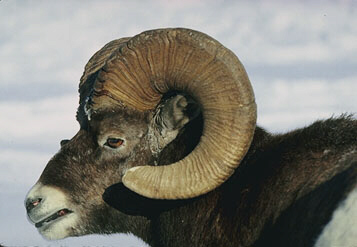Peninsular Bighorn Sheep
Ovis canadensis
One of the most majestic creatures of the North American
deserts, and one of the rarest, is the Desert Bighorn Sheep.

The ram is recognized by his massive brown horns. He can have a
set of horns with a full curl and a spread of 33 inches.
The ewes are slightly smaller and have shorter, smaller
horns that never exceed half a curl.
The Bighorn, live in dry, desert mountain ranges, which is
almost waterless and hardly any vegetation. In the summer
when the temperatures can reach up to 120 degrees the Bighorns rely on desert plants for both food and moisture. They use their hooves and horns to remove the spines of the cacti, then eat the juicy insides.
They have superior eyesight and agility, Bighorn Sheep have few natural predators. But destruction of their natural habitat, and parasites and diseases transmitted from domestic sheep, have severely impacted the Desert Bighorn population.
In 1933, Anza-Borrego became a state park, for the purpose of preserving the habitat of the Peninsular Bighorn Sheep. Since then, their numbers have decreased, and spotting a Bighorn has become a rare experience in California. Anza-Borrego is one of the last refuges of the Peninsular Bighorn Sheep. Only 280 of this subspecies remain in the United States and 200 find refuge in the park.
Humans are responsible for the Bighorn's destruction. Grazing, mining, depletion of water holes, homesteading, and use as camp meat spelled disaster for the Bighorn. An alarming decline has been occurring. It has been documented that a drop from about 120 sheep in 1972 to less than 40. Off-road vehicles, trespassing cattle, poaching in the 1960s and early '70s, drought, disease and Mountain Lion predation have worked together to push this population to the edge.




